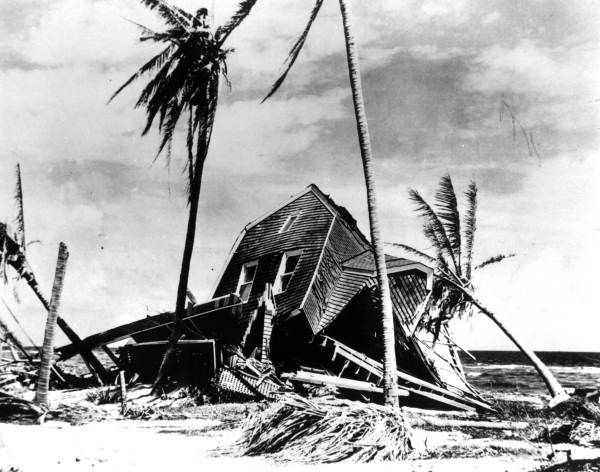Factoids
Hurricanes are one of the most misunderstood natural phenomena.
They come in all shapes and sizes and strengths — and they wreak havoc in many ways. Perhaps it’s the variety that confuses folks.
Here are 12 things you should know.
1. Definition
A hurricane is a rotating storm with winds of at least 74 mph that originates in or near the tropics. Hurricanes form over the ocean, and warm water is the hurricane’s fuel source, so it eventually dies once it moves over land or colder water.
2. Eyewall
A hurricane is typically hundreds of miles across, but the really destructive part is smaller — a concentrated inner ring of intense wind and rain surrounding the center. This is the eyewall, and it’s the worst part of a hurricane. If the eyewall passes over you, that’s a direct hit.
3. Eye
Inside the eyewall is the hurricane’s calm center — the eye. When the eye reaches you, the wind and rain will suddenly stop, and the sun might come out. But don’t get comfortable, because you’re only halfway through the storm. After anywhere from a few minutes to a few hours, the eye will pass and the backside of the storm will hit — possibly with even greater force.
4. Saffir-Simpson Hurricane Wind Scale
- Category 1: Winds 74-95 mph – Very dangerous winds will produce some damage: Well-constructed frame homes could have damage to roof, shingles, vinyl siding and gutters.
- Category 2: Winds 96-110 mph – Extremely dangerous winds will cause extensive damage: Well-constructed frame homes could sustain major roof and siding damage.
- Category 3: Winds 111-129 mph – Devastating damage will occur: Well-built framed homes may incur major damage or removal of roof decking and gable ends.
- Category 4: Winds 130-156 mph – Catastrophic damage will occur: Well-built framed homes can sustain severe damage with loss of most of the roof structure and/or some exterior walls.
- Category 5: Winds over 156 mph – Catastrophic damage will occur: A high percentage of framed homes will be destroyed, with total roof failure and wall collapse.
5. Destructive forces
- High winds — which damage houses, buildings, signs, and vehicles.
- Storm surge — coastal flooding caused by the ocean surging onto land.
- Heavy rainfall — which also causes flooding.
- Tornadoes — usually happening in the outer edges of the hurricane.
6. Rainfall
Hurricanes dump heavy rain, which causes flooding. While winds and storm surge are tied to a hurricane’s strength — meaning these destructive forces get worse as the hurricane gets stronger — rainfall is not tied to the hurricane’s strength. That means even a Category 1 hurricane — or a storm below hurricane force — can cause epic rainfall and catastrophic flooding.
7. Storm surge
Hurricane winds push the ocean up onto land, causing serious coastal inundation. This phenomenon is called storm surge, and it’s destructive and dangerous. In the U.S., storm surge is responsible for about half of all hurricane fatalities — and it’s the main reason why folks flee the coast as a hurricane approaches.
Storm surge factors
As a hurricane approaches the coast, it’s hard to predict the size of the storm surge because there are so many variables. But we do know that stronger, larger, and slower-moving hurricanes tend to produce higher surges — and therefore greater inundation. Also, if the slope of the continental shelf offshore is gentle — so that there’s a large area of shallow water just offshore — that augments surge as well. Unfortunately, this is the case for a lot of America’s Gulf Coast.
8. Winds
A hurricane is categorized on a five-level scale based on its estimated maximum winds. A Category 1 has winds of 74-95 mph and is relatively common. A Category 5 — a rare occurrence — has winds over 156 mph and inflicts catastrophic damage. The National Hurricane Center describes all hurricanes of Category 3 or higher as major hurricanes.

9. Size vs strength
Hurricanes come in many sizes: some cover a very small area, whereas others can span almost the entire Gulf of Mexico. The strength of a hurricane is unrelated to its size. Just because a hurricane is large doesn’t mean it’s strong. In fact, the strongest hurricanes in U.S. history — the Category 5s — were all on the small side. That said, larger hurricanes tend to produce higher storm surges and more rainfall than smaller hurricanes.
10. Strong side
Usually — but not always — winds on the right side of the hurricane (if you’re facing the direction the storm is moving) are stronger and more destructive. Also, it’s on the right side that winds are blowing toward the coast and pushing the storm surge onshore. So, it really matters which side of the hurricane you’re on as it makes landfall.
11. Which American hurricane caused the most damage, monetarily?
The most destructive American hurricane on record is Katrina of 2005. The storm devastated Metro New Orleans and Coastal Mississippi, with the damage totaling an incredible $186 billion (adjusted to 2022 dollars).
12. What was the strongest hurricane?
For wind speed, Hurricane Patricia of 2015 is at the top. This Eastern Pacific storm generated winds at an incredible 215 mph before it weakened and hit Mexico. On the Atlantic side, Allen of 1980 officially tops the record books at 190 mph — but this value is controversial and modern researchers may eventually adjust it down.
